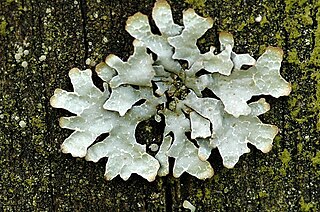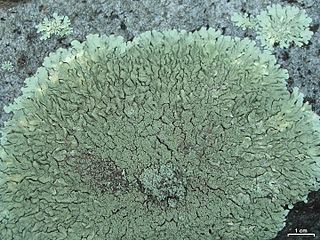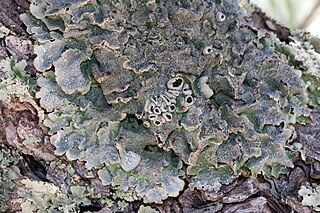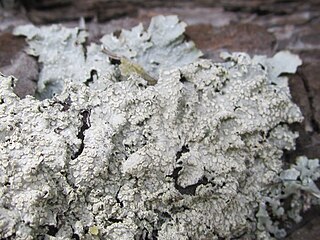
Parmelia is a genus of medium to large foliose (leafy) lichens. It has a global distribution, extending from the Arctic to the Antarctic continent but concentrated in temperate regions. There are about 40 species in Parmelia. In recent decades, the once large genus Parmelia has been divided into a number of smaller genera according to thallus morphology and phylogenetic relatedness.

Parmelia sulcata, commonly known as the hammered shield lichen or cracked-shield lichen, is a foliose lichen in the family Parmeliaceae. First described by Thomas Taylor in 1836, it is one of the most prevalent lichen species globally, known for its resilience to pollution and cosmopolitan distribution across temperate and cold regions of both hemispheres. P. sulcata forms a circular thallus up to 10 cm (4 in) in diameter, with a glaucous white to grey upper surface and a black lower surface, featuring broadly lobed structures with both marginal and laminal soralia and a distinctive reticulate pattern of pseudocyphellae.
Pseudoramonia is a genus of lichen-forming fungi in the family Graphidaceae. The genus was circumscribed by lichenologists Gintaras Kantvilas and Antonín Vězda in 2000, with the type species designated as Pseudoramonia stipitata.

Canoparmelia is a genus of lichen-forming fungi in the family Parmeliaceae. The widespread genus contains about 35 species. Canoparmelia, a segregate of the parmelioid lichen genus Pseudoparmelia, was circumscribed by John Elix and Mason Hale in 1986.

Parmotrema is a genus of lichen belonging to the family Parmeliaceae. It is a large genus, containing an estimated 300 species, with a centre of diversity in subtropical regions of South America and the Pacific Islands.

Xanthoparmelia is a genus of foliose lichens in the family Parmeliaceae. This genus of lichen is commonly found in the United States, South America, southern Africa, Europe, Australia, and New Zealand.
Parmotrema aldabrense is a species of lichen in the family Parmeliaceae that is found in Africa. It was first described by Carroll William Dodge in 1959 as a species of Parmelia. Mason Hale transferred it to the genus Parmotrema in 1974. The type collection was made in the Aldabra Islands, where it was found growing on tamarind. It has also been recorded from Madagascar. The lichen has an olive-buff coloured thallus measuring up to 14 cm (5.5 in) in diameter.

Parmotrema zollingeri is a species of lichen in the family Parmeliaceae. It was originally described in 1860 as a species of Parmelia by German lichenologist Johann Adam Philipp Hepp, and named after Swiss botanist Heinrich Zollinger. Mason Hale transferred it to the genus Parmotrema in 1974.

Parmotrema rampoddense, commonly known as the long-whiskered ruffle lichen, is a species of foliose lichen in the family Parmeliaceae. It is widely distributed in tropical regions and grows on the bark of oak and palm trees.

Parmotrema arnoldii, commonly known as the powdered ruffle lichen, is a widely distributed species of lichen in the family Parmeliaceae. It has been recorded from Africa, Asia, Europe, Oceania, Macaronesia, and North and South America.
Bulbothrix meizospora is a species of foliose lichen in the family Parmeliaceae. It is found in Africa, Asia, and South America, where it grows on tree bark.

Punctelia punctilla is a species of foliose lichen in the family Parmeliaceae. It is found in Africa, South America, and North America, where it grows on bark and on rocks. The main characteristics that distinguish Punctelia punctilla from other species of Punctelia are the presence of isidia on the thallus surface, a pale brown thallus undersurface, and the presence of lecanoric acid in the medulla.

Punctelia hypoleucites, commonly known as the southwestern speckled shield lichen, is a species of foliose (leafy) lichen in the family Parmeliaceae. First formally described by Finnish botanist William Nylander as a species of Parmelia, it was transferred to the genus Punctelia in 1982. The lichen is found in Africa, North America, and South America, where it grows on the bark of both hardwood and coniferous trees. Its greenish-grey thallus is covered with tiny white pseudocyphellae – minute holes in the thallus surface that facilitate gas exchange. Some macroscopic features that help distinguish this species from other related members of the genus include the presence and the structure of the apothecia, the absence of asexual surface propagules, and the light brown color of the thallus undersurface. Chemically, the presence of lecanoric acid in the medulla and atranorin in the cortex help distinguish it from lookalikes.

Punctelia perreticulata is a widely distributed species of foliose lichen in the family Parmeliaceae. It occurs in Mediterranean Europe and Russia, North America, South America, Australia, and New Zealand, where it grows on rocks, bark, or wood. Its main distinguishing features are its thallus surface, marked with many shallow depressions, grooves, or pits, and sorediate pseudocyphellae. The lower side of the thallus is ivory to tan towards the centre and the major secondary metabolite in the medulla is lecanoric acid. A lookalike species with which it has been historically confused is Punctelia subrudecta; this lichen can be distinguished from Punctelia perreticulata by the texture of the thallus surface, or, more reliably, by the length of its conidia.

Punctelia graminicola is a species of foliose (leafy) lichen in the family Parmeliaceae. It grows on rocks, and, less frequently, on bark in North America, South America, and East Africa. It has a blue-grey thallus measuring up to about 15 cm (6 in), covered with tiny pores called pseudocyphellae. Sometimes the lichen forms small lobes that project out from the surface. Fruiting bodies are uncommon in this species; if present, they resemble small cups with a brown internal disc measuring 3–10 mm (0.1–0.4 in) in diameter. A lookalike species, Punctelia hypoleucites, is not readily distinguishable from Punctelia graminicola by appearance or habitat alone; these species can only be reliably differentiated by examining the length of their conidia.

Punctelia borreri is a species of foliose lichen in the family Parmeliaceae. It is a common and widely distributed species, occurring in tropical, subtropical, and temperate regions of Africa, Asia, Europe, North America, Oceania, and South America. The lichen typically grows on bark of deciduous trees, and less commonly on rock. Some European countries have reported increases in the geographic range or regional frequency of the lichen in recent decades, attributed alternatively to a reduction of atmospheric sulphur dioxide levels or an increase in temperatures resulting from climate change.
Clandestinotrema is a genus of lichen-forming fungi in the family Graphidaceae. It has 17 species. They typically inhabit montane and cloud forest at higher elevations in the tropics.
Lempholemma polycarpum is a little-known species of saxicolous (rock-dwelling) lichen in the family Lichinaceae. It was first described from Yemen and is characterised by its blackish thallus, abundant small apothecia, and cyanobacteria from the genus Nostoc as its photobiont. The lichen is found on inclined limestone boulders in sun-exposed habitats with open forest vegetation. It also occurs in Madagascar and in Aldabra.

Arctoparmelia incurva is a species of saxicolous (rock-dwelling), foliose lichen in the family Parmeliaceae. First described in 1794 by Christiaan Hendrik Persoon, it has undergone several taxonomic reclassifications before being placed in its current genus in 1986. This yellowish-green lichen, characterised by its narrow, convex lobes and globular soralia, typically grows on sun-exposed siliceous rocks in alpine and arctic habitats. It has a circumpolar distribution, found across North America, Europe, and parts of Asia. A. incurva can be distinguished from similar species by its specific morphological features and chemical spot test reactions. The lichen is known to host several parasitic fungi and has shown tolerance to acid pollution.

Parmotrema xanthinum is a species of corticolous (bark-dwelling), foliose lichen in the family Parmeliaceae. It has a pale yellowish to greenish-grey body (thallus) that attaches loosely to its bark surface. First described in 1884, it was the subject of recent taxonomic studies that showed it to be the same species as the previously distinct Parmotrema madagascariaceum. The lichen can be identified by its broad lobes, 10–20 cm (4–8 in) across, with small finger-like projections (isidia) on its surface and hair-like projections along its edges. While particularly common in southeastern North America, including coastal and mountainous regions, it is widely distributed in subtropical and temperate areas worldwide. The species can be chemically distinguished by the presence of specific secondary metabolites including usnic acid and protolichinestrinic acid in its tissues.














